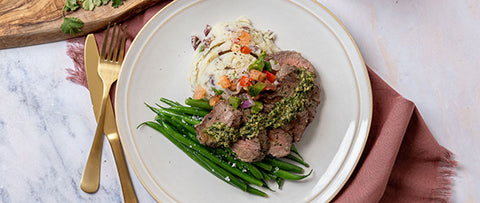When it comes to sauces, they can really make or break the macros and flavor of a meal. To choose the healthiest sauces, we must first understand how they’re made.
Sauces are either a liquid, a cream, or a solid, like salsa (salsa is a latin word meaning sauce; other forms of solids are chutneys, relishes, and compotes). They’re either raw ingredients or cooked down to add flavor, color, and texture to a meal. At The Culinary Institute Le Cordon Bleu, we were traditionally trained on the 5 “mother sauces”--five basic sauces that many variations or “daughter sauces” can be created from. These include:
- Bechamel - milk-based sauce, thickened with roux (flour and butter or oil)
- Espagnole - brown stock, mirepoix (onion, celery, carrot) tomatoes & roux (flour and butter or oil)
- Veloute - light stock-based sauce, thickened with a roux (flour and butter or oil)
- Hollandaise - an emulsion of egg yolk, clarified butter and lemon (or vinegar)
- Tomato - tomato-based sauce
You will see these sauces in any restaurant that executes fine cooking skills, but most aren’t healthy. With just a small portion you could rack up hundreds of calories! They’re rich in fats and sometimes sodium, too. To create healthy sauces, ingredients are substituted to give you the same flavor experience but not break your nutrition.
What Makes a Sauce Healthy or Unhealthy
A healthy sauce is one with ingredients your body can easily digest, as well as ones that are not high in sugars, saturated fats and salt. These things do not help when it comes to weight loss/management. Almost everything is fine in moderation, but if you want to enjoy delicious food more often, healthier sauces are going to be key.
When cooking at fit-flavors, we love to take traditional cooking techniques and re-invent them with healthier ingredients. Don’t get me wrong, proper cooking is necessary for food to taste great, but our health is more important and I will always find a better option to make sauces healthy.
For example, we use a 1% milk when making a bechamel for our mac n cheese, vs a whole milk, and we use a house-made marinade on proteins, vs finishing in butter sauces.
Marinades are a great example of how you can add a ton of flavor with quality ingredients. Take for instance chimichurri, it’s made with fresh herbs, garlic, olive oil, red wine vinegar and salt and pepper. A serving of this has less calories than 1 Tbsp of olive oil!
Sauce Makes Everything Better
Why even talk about sauce so much? I think we can agree sauce makes everything better. Sauces add moisture and kick up the flavors of a meal or snack. We must enjoy the foods we eat if we’re going to make healthy eating a lifestyle. If not, the so called “diet” we’re trying to follow will be short lived because it’s boring.
You don’t have to forgo flavor for health, you just have to pay attention to quality and balance when creating or looking for sauces.
How to Create & Find Healthy Sauces
Quality Ingredients
Knowing the base of your sauce will help you determine if it’s clean or one you’ll want to limit. If you know a sauce is a butter sauce, it’s going to be very high in fat. For example, a butter cream sauce or a Bearnaise sauce (daughter sauce of Hollandaise - butter and egg yolks) is something you’ll want to have in moderation.
Sometimes a homemade mac n cheese is what we need, and we shouldn’t deny ourselves that! We just don’t want to eat the full-fat version often to live a healthy lifestyle. Substituting with ingredients like whole wheat pasta, olive oil, salt and pepper and a sprinkle of parmesan is a healthier way to enjoy cheesy noodles more regularly. Or, make your own bechamel with 1% milk, and fold in some cauliflower or butternut squash puree--these are quality ingredients swaps you can make to enjoy your favorite foods more often in a healthy way. I always hide veggies in my kids mac n cheese at home!
Quality ingredients for sauces could include heart healthy fats in place of saturated and trans fats, and complex carbohydrates that digest more slowly and keep us fuller longer in place of simple carbohydrates. Always try to choose real food ingredients that are minimally processed.
Take icing on a cake for example. I know it’s not a sauce but it kind of is for cake 🍰. Many pre-made icings from stores have hydrogenated oils, processed sugars and food dye. Basically chemicals, which cause a traffic jam in your body. I prefer to make icing at home because I can make it with grass fed butter and real sugar, or heavy whipping cream and maple syrup. This is where I love to enjoy something sweet, but opt for a cleaner way to consume it. I know my body is happy with food it recognizes.
Balance & Portion Control
When it comes to portions, know that sauce is typically part of a meal, so the calories will mostly come from the meal.
- If it’s a fattening sauce with a base of butter, oil, or cream, keep it to 1 Tbsp. That will keep you in a healthy calorie and fat range.
- If it’s a vegetable based sauce, you’re probably good to have a much larger serving like ¼ -½ cup.
- If you’re cooking for your family, keep in mind how many servings you’re hoping to yield. Then keep your Tbsps of cooking oils or fats equal to or close to the number of servings. For example, if you’re making pasta with chicken, saute the chicken breast with 1-2Tbsp of oil and use the other 2 servings to top your pasta with cheese or oil.
From Scratch or From a Bottle
When creating sauces at home, it’s good to have healthy condiment staples. Here are some great items to have on hand:
- Oils (Olive, coconut, canola, avocado, sesame)
- Vinegars (apple cider, balsamic, red wine, rice)
- Nut butters (peanut and almond butters - naturals are best)
- Mustards
- Sugars (honey, maple syrup, agave nectar)
- Soy sauce (low sodium and/or gluten free options)
- Hot sauce (srirachas, go for ones lower in sodium)
- Ghee (clarified butter that is typically grass fed and can be cooked at higher smoke point)
I like to keep my sauces super clean, so I have these staples on hand to make healthy sauces at home more regularly.
Or if you’re short on time, shop for products at the grocery store that don’t contain high saturated fats, sugar and or sodium. I like to make BBQ sauce and marinara at home, but keep some store bought around just in case. When purchasing a BBQ sauce, low sugar per serving is key. With marinaras, stick with low sodium and sugar. I try to find one with less than 300mg per serving of sodium and 5g-6g or less of sugar per serving.
At the end of the day, it comes down to flavor and convenience. We want what tastes good, and fast. Something quick things you can do:
- Assemble an oil and vinegar dressing/marinade. Build a flavor profile and pureé herbs, aromatics and oils to create a marinade for meat, veggies or pastas.
- Combine soy sauce, honey, sriracha, and rice wine vinegar for a low calorie sauce to saute Asian veggies.
- Buy a low sugar, pre-made ketchup.
- Buy a Caesar that is made with natural ingredients.
- Buy a natural peanut butter.
Best wishes on your sauces adventures! Check out my oil and vinegar dressing recipe for an easy vinaigrette that can be used as a dressing or marinade.






